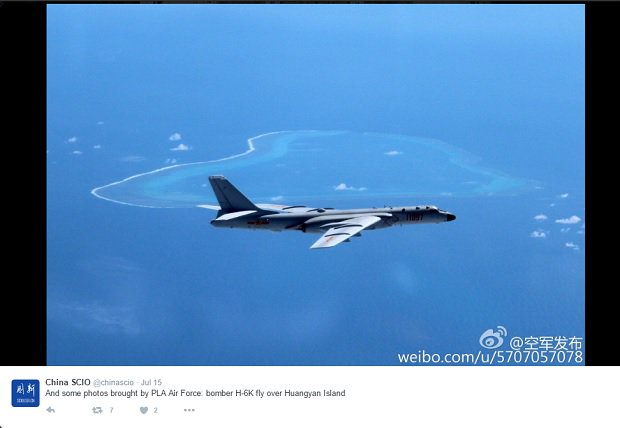
China has announced that it has landed long-range nuclear-capable bombers on one of its artificial islands in the South China Sea.
Posting on Twitter yesterday (Friday, May 18), the state-run newspaper People’s Daily wrote: “Chinese bombers including the H-6K conduct takeoff and landing training on an island reef at a southern sea area.” The tweet was confirmed by an article published on the paper’s website today.
Washington-based think tank Asia Maritime Transparency Initiative (AMTI) said a video accompanying the post showed a long-range bomber landing and taking off, and was filmed from Woody Island.
“The base H-6 aircraft’s combat radius of nearly 1,000 nautical miles means even China’s basic bombers taking off from Woody Island could cover the entire South China Sea,” AMTI wrote.
“Nearly all of the Philippines falls within the radius of the bombers, including Manila and all five Philippine military bases earmarked for development under the US-Philippines Enhanced Defense Cooperation Agreement (EDCA).
“An H-6K, with its technical upgrades giving it a combat radius of nearly 1,900 nautical miles, would dwarf this radius, putting all of Southeast Asia in range of flights from Woody Island,” it added.
The agreed locations for the EDCA are Basa Air Base in Pampanga, Antonio Bautista Air Base in Palawan, Lumbia Air Base in Cagayan de Oro City, Mactan-Buenito Ebbed Air Base in Cebu and Fort Magsaysay in Nueva Ecija.
The AMTI also said that future deployments in the Spratlys would bring Singapore and much of Indonesia within range of even China’s lower-end bombers, while the H-6Ks could reach northern Australia — as well as US defence facilities on Guam.
“No doubt it will soon land on an island in Spratlys since hangars there are built to accommodate bombers,” wrote Bonnie Glaser, director of the China Power project at the Center for Strategic International Studies, on Twitter.
China has three airstrips in the Spratlys which can accommodate fighter planes — Panganiban (Mischief), Kagitingan (Fiery Cross), and Zamora (Subi).
Panganiban is inside the Philippines’ exclusive economic zone, while Zamora is 12 nautical miles from Philippine-occupied Pagasa Island (Thitu). Kagitingan is outside but near the Philippine EEZ.
Chinese foreign ministry spokeswoman Hua Chunying earlier said China has been involved in peaceful construction in the islands, which includes “the deployment of necessary national defence facilities”.
In response, the White House warned China of “near-term and long-term consequences” over its growing militarisation in the South China Sea. The US did not say what the consequences would be.
The Philippine military today assured Filipinos that it would defend the country’s territory following the latest deployment.
“Your Armed Forces are always aware and will not renege on our beholden constitutional duties to protect our sovereignty and maintain our territorial areas,” military spokesperson Colonel Edgard Arevalo told reporters at the end of the annual US-Philippines “Balikatan” exercises.

Comments are closed.